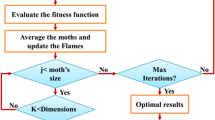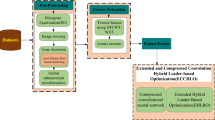Abstract
Corona Virus disease 2019 (Covid-19) is an acute disease that affects the respiratory system alveolar of the human, which leads to serious illness and may cause death. When an infected person coughs, sneezes, speaks, sings, or breathes, the virus can spread from their mouth or nose in minute liquid particles. Disease diagnosis using Computed Tomography (CT) images is widely utilized to detect infection; still, accurate detection is a challenging task. Hence, this research introduces a novel hybrid optimization enabled DenseNet for Covid-19 classification. The hybrid optimization, named Gradient Mutated Leader Algorithm (GMLA) is proposed for tuning the weights of DenseNet by combining the Mutated leader's behavior in guiding the group member in position updation with the gradient descent algorithm for the acquisition of computation efficiency with stable convergence, which helps to obtain the global best solution for tuning the DenseNet's weights to make the classification more accurate. In addition, the proposed GMLA_DenseNet utilizes the data augmentation technique using rotating, shifting, zooming, and flipping to obtain balanced data with enormous data sizes, which makes the classification more efficient. The performance of GMLA_DenseNet is evaluated using True Negative Rate (TNR), True Positive Rate (TPR), Precision, and segmentation accuracy and obtained the maximal values of 0.920, 0.919, 0.919, and 0.919, respectively.












Similar content being viewed by others
Data Availability
The data underlying this article is UCSD-AI4H/COVID-CT dataset taken from, "https://github.com/UCSD-AI4H/COVID-CT", accessed on June 2022.
References
Jiang, Y., Chen, H., Loew, M., & Ko, H. (2020). COVID-19 CT image synthesis with a conditional generative adversarial network. IEEE Journal of Biomedical and Health Informatics, 25(2), 441–452.
Guan, W. J., Ni, Z. Y., Hu, Y., Liang, W. H., Ou, C. Q., He, J. X., Liu, L., Shan, H., Lei, C. L., Hui, D. S., & Du, B. (2020). Clinical characteristics of coronavirus disease 2019 in China. New England Journal of Medicine, 382(18), 1708–1720.
Hu, S., Gao, Y., Niu, Z., Jiang, Y., Li, L., Xiao, X., Wang, M., Fang, E. F., Menpes-Smith, W., Xia, J., & Ye, H. (2020). Weakly supervised deep learning for covid-19 infection detection and classification from CT images. IEEE Access, 8, 118869–118883.
Turkoglu, M. (2021). COVID-19 detection system using chest CT images and multiple kernels-extreme learning machine based on deep neural network. IRBM, 42(4), 207–214.
Perumal, V., Narayanan, V., & Rajasekar, S. J. S. (2021). Detection of COVID-19 using CXR and CT images using transfer learning and haralick features. Applied Intelligence, 51(1), 341–358.
Shamrat, F. J. M., Azam, S., Karim, A., Ahmed, K., Bui, F. M., & De Boer, F. (2023). High-precision multiclass classification of lung disease through customized MobileNetV2 from chest X-ray images. Computers in Biology and Medicine, 155, 106646.
Shamrat, F. J. M., Azam, S., Karim, A., Islam, R., Tasnim, Z., Ghosh, P., & De Boer, F. (2022). LungNet22: A fine-tuned model for multiclass classification and prediction of lung disease using X-ray images. Journal of Personalized Medicine, 12(5), 680.
Ai, T., Yang, Z., Hou, H., Zhan, C., Chen, C., Lv, W., Tao, Q., Sun, Z., & Xia, L. (2020). Correlation of chest CT and RT-PCR testing in coronavirus disease 2019 (COVID-19) in China: a report of 1014 cases. Radiology, 296(2), 32–40.
Fang, Y., Zhang, H., Xie, J., Lin, M., Ying, L., Pang, P., & Ji, W. (2020). Sensitivity of chest CT for COVID-19: Comparison to RT-PCR. Radiology, 296, 115–117.
Aminian, A., Safari, S., Razeghian-Jahromi, A., Ghorbani, M., & Delaney, C. P. (2020). COVID-19 outbreak and surgical practice: Unexpected fatality in perioperative period. Annals of Surgery. https://doi.org/10.1097/SLA.0000000000003925
Chan, J. F. W., Yuan, S., Kok, K. H., To, K. K. W., Chu, H., Yang, J., Xing, F., Liu, J., Yip, C. C. Y., Poon, R. W. S., & Tsoi, H. W. (2020). A familial cluster of pneumonia associated with the 2019 novel coronavirus indicating person-to-person transmission: A study of a family cluster. The Lancet, 395(10223), 514–523.
Gao, K., Su, J., Jiang, Z., Zeng, L. L., Feng, Z., Shen, H., Rong, P., Xu, X., Qin, J., Yang, Y., & Wang, W. (2021). Dual-branch combination network (DCN): Towards accurate diagnosis and lesion segmentation of COVID-19 using CT images. Medical Image Analysis, 67, 101836.
Liu, Q., Leung, C. K., & Hu, P. (2020). A two-dimensional sparse matrix profile DenseNet for COVID-19 diagnosis using chest CT images. IEEE Access, 8, 213718–213728.
Udugama, B., Kadhiresan, P., Kozlowski, H. N., Malekjahani, A., Osborne, M., Li, V. Y., Chen, H., Mubareka, S., Gubbay, J. B., & Chan, W. C. (2020). Diagnosing COVID-19: The disease and tools for detection. ACS Nano, 14(4), 3822–3835.
Ying, X., Guo, H., Ma, K., Wu, J., Weng, Z. and Zheng, Y., X2CT-GAN: reconstructing CT from biplanar X-rays with generative adversarial networks. In Proceedings of the IEEE/CVF Conference on Computer Vision and Pattern Recognition, pp. 10619–10628 (2019).
Akter, S., Shamrat, F. M. J. M., Chakraborty, S., Karim, A., & Azam, S. (2021). COVID-19 detection using deep learning algorithm on chest X-ray images. Biology, 2021(10), 1174.
Arivoli, A., Golwala, D., & Reddy, R. (2022). CoviExpert: COVID-19 detection from chest X-ray using CNN. Measurement Sensors, 22, 100392.
Zhang, Z., Romero, A., Muckley, M.J., Vincent, P., Yang, L. and Drozdzal, M., Reducing uncertainty in undersampled MRI reconstruction with active acquisition. In Proceedings of the IEEE/CVF Conference on Computer Vision and Pattern Recognition, pp. 2049–2058 (2019).
Yan, K., Peng, Y., Sandfort, V., Bagheri, M., Lu, Z. and Summers, R.M., Holistic and comprehensive annotation of clinically significant findings on diverse CT images: learning from radiology reports and label ontology. In Proceedings of the IEEE/CVF Conference on Computer Vision and Pattern Recognition, pp. 8523–8532, (2019).
Ragab, M., Alshehri, S., Alhakamy, N. A., Mansour, R. F., & Koundal, D. (2022). Multiclass classification of chest X-ray images for the prediction of COVID-19 using capsule network. Computational Intelligence and Neuroscience, 2022, 4565214. https://doi.org/10.1155/2022/6185013
Zhang, M., Wu, Q., Chen, H., Heidari, A. A., Cai, Z., Li, J., & Mansour, R. F. (2023). Whale optimization with random contraction and Rosenbrock method for COVID-19 disease prediction. Biomedical Signal Processing and Control, 83, 104638.
Rajaraman, S., Candemir, S., Kim, I., Thoma, G., & Antani, S. (2018). Visualization and interpretation of convolutional neural network predictions in detecting pneumonia in pediatric chest radiographs. Applied Sciences, 8(10), 1715.
Xue, Yu., Onzo, B.-M., Mansour, R. F., & Shoubao, Su. (2022). Deep convolutional neural network approach for COVID-19 detection. Computer Systems Science and Engineering, 42(1), 201–211.
Song, Y., Zheng, S., Li, L., Zhang, X., Zhang, X., Huang, Z., Chen, J., Wang, R., Zhao, H., Chong, Y., & Shen, J. (2021). Deep learning enables accurate diagnosis of novel coronavirus (COVID-19) with CT images. IEEE/ACM transactions on computational biology and bioinformatics, 18(6), 2775–2780.
Shamsi, A., Asgharnezhad, H., Jokandan, S. S., Khosravi, A., Kebria, P. M., Nahavandi, D., Nahavandi, S., & Srinivasan, D. (2021). An uncertainty-aware transfer learning-based framework for covid-19 diagnosis. IEEE Transactions on Neural Networks and Learning Systems, 32(4), 1408–1417.
Singh, A. K., Kumar, A., Mahmud, M., Kaiser, M. S., & Kishore, A. (2021). COVID-19 infection detection from chest X-ray images using hybrid social group optimization and support vector classifier. Cognitive Computation, 56, 1–13.
UCSD-AI4H/COVID-CT dataset taken from, "https://github.com/UCSD-AI4H/COVID-CT", accessed on June (2022).
Kavitha, P. and Prabakaran, S., A Novel Hybrid Segmentation Method with Particle Swarm Optimization and Fuzzy C-mean Based on Partitioning the Image for Detecting Lung Cancer (2019).
Zhou, Z., Rahman Siddiquee, M.M., Tajbakhsh, N. and Liang, J., Unet++: A nested u-net architecture for medical image segmentation. In Deep Learning in Medical Image Analysis and Multimodal Learning for Clinical Decision Support, pp. 3–11, (2018).
Baby, Y. R., & Sumathy, V. K. R. (2020). Kernel-based Bayesian clustering of computed tomography images for lung nodule segmentation. IET Image Process., 14(5), 890–900.
Data augmentation, “https://www.geeksforgeeks.org/python-data-augmentation/”, last accessed on September (2022).
Zulpe, N., & Pawar, V. (2012). GLCM textural features for brain tumor classification. International Journal of Computer Science Issues (IJCSI), 9(3), 354.
Zeng, H., Zhang, R., Huang, M., & Wang, X. (2015). Compact local directional texture pattern for local image description. Advances in Multimedia, 2015, 8–8.
Huang, G., Liu, Z., Van Der Maaten, L. and Weinberger, K.Q., Densely connected convolutional networks In Proceedings of the IEEE Conference on Computer Vision and Pattern Recognition, pp. 4700–4708, (2017).
Chauhan, T., Palivela, H., & Tiwari, S. (2021). Optimization and fine-tuning of DenseNet model for classification of Covid-19 cases in medical imaging. International Journal of Information Management Data Insights, 1(2), 100020.
Zeidabadi, F. A., Doumari, S. A., Dehghani, M., Montazeri, Z., Trojovsky, P., & Dhiman, G. (2022). MLA: A new mutated leader algorithm for solving optimization problems. Computers, Materials & Continua, 70(3), 5631–5649.
Ruder, S., "An overview of gradient descent optimization algorithms", arXiv preprint arXiv:1609.04747 (2016).
Yang, H., Zhang, J., Zhao, Y., Ji, Y., Han, J., Lin, Y., & Lee, Y. (2015). CSO: Cross stratum optimization for optical as a service. IEEE Communications Magazine, 53(8), 130–139.
Askari, Q., Younas, I., & Saeed, M. (2020). Political Optimizer: A novel socio-inspired meta-heuristic for global optimization. knowledge-based systems, 195, 105709.
Das, B., Mukherjee, V., & Das, D. (2020). Student psychology based optimization algorithm: A new population based optimization algorithm for solving optimization problems. Advances in Engineering software, 146, 102804.
Saha, S., Mou, L., Qiu, C., Zhu, X. X., Bovolo, F., & Bruzzone, L. (2020). Unsupervised deep joint segmentation of multitemporal high-resolution images. IEEE Transactions on Geoscience and Remote Sensing, 58(12), 8780–8792.
Saood, A., & Hatem, I. (2021). COVID-19 lung CT image segmentation using deep learning methods: U-Net versus SegNet. BMC Medical Imaging, 21(1), 1–10.
Acknowledgements
I would like to express my very great appreciation to the co-authors of this manuscript for their valuable and constructive suggestions during the planning and development of this research work.
Funding
This research did not receive any specific funding.
Author information
Authors and Affiliations
Contributions
All authors have made substantial contributions to conception and design, revising the manuscript, and the final approval of the version to be published. Also, all authors agreed to be accountable for all aspects of the work in ensuring that questions related to the accuracy or integrity of any part of the work are appropriately investigated and resolved.
Corresponding author
Ethics declarations
Conflict of interest
The authors declare no conflict of interest.
Additional information
Publisher's Note
Springer Nature remains neutral with regard to jurisdictional claims in published maps and institutional affiliations.
Rights and permissions
Springer Nature or its licensor (e.g. a society or other partner) holds exclusive rights to this article under a publishing agreement with the author(s) or other rightsholder(s); author self-archiving of the accepted manuscript version of this article is solely governed by the terms of such publishing agreement and applicable law.
About this article
Cite this article
Karthi, S., Sudha, L.R. & Navaneetha Krishnan, M. A Novel Hybrid Optimization Enabled Densenet for Covid-19 Classification using CT Images. Sens Imaging 24, 31 (2023). https://doi.org/10.1007/s11220-023-00434-5
Received:
Revised:
Accepted:
Published:
DOI: https://doi.org/10.1007/s11220-023-00434-5




